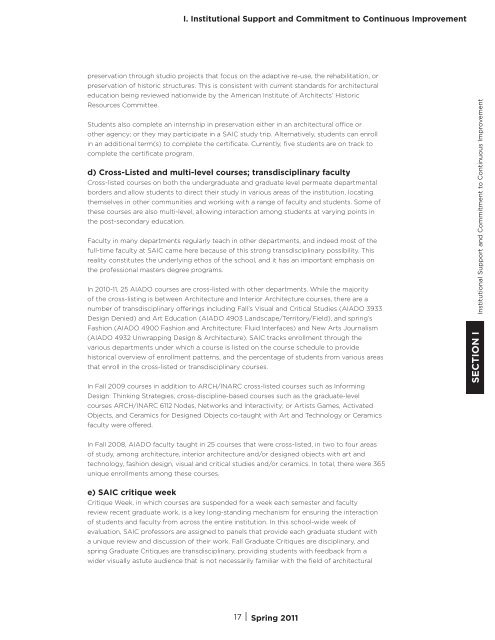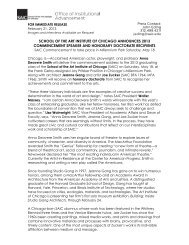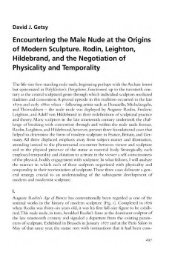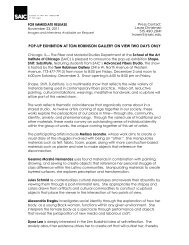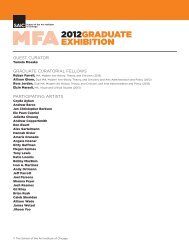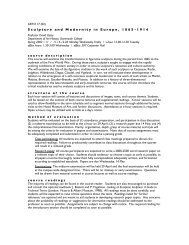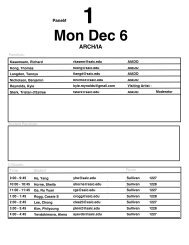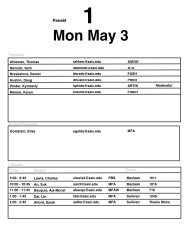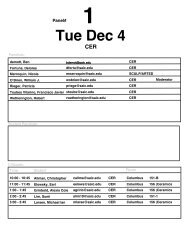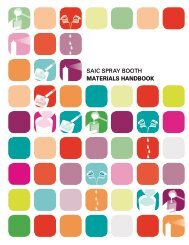i. institutional support and commitment to continuous improvement
i. institutional support and commitment to continuous improvement
i. institutional support and commitment to continuous improvement
You also want an ePaper? Increase the reach of your titles
YUMPU automatically turns print PDFs into web optimized ePapers that Google loves.
I. Institutional Support <strong>and</strong> Commitment <strong>to</strong> Continuous Improvement<br />
preservation through studio projects that focus on the adaptive re-use, the rehabilitation, or<br />
preservation of his<strong>to</strong>ric structures. This is consistent with current st<strong>and</strong>ards for architectural<br />
education being reviewed nationwide by the American Institute of Architects’ His<strong>to</strong>ric<br />
Resources Committee.<br />
Students also complete an internship in preservation either in an architectural office or<br />
other agency; or they may participate in a SAIC study trip. Alternatively, students can enroll<br />
in an additional term(s) <strong>to</strong> complete the certificate. Currently, five students are on track <strong>to</strong><br />
complete the certificate program.<br />
d) Cross-Listed <strong>and</strong> multi-level courses; transdisciplinary faculty<br />
Cross-listed courses on both the undergraduate <strong>and</strong> graduate level permeate departmental<br />
borders <strong>and</strong> allow students <strong>to</strong> direct their study in various areas of the institution, locating<br />
themselves in other communities <strong>and</strong> working with a range of faculty <strong>and</strong> students. Some of<br />
these courses are also multi-level, allowing interaction among students at varying points in<br />
the post-secondary education.<br />
Faculty in many departments regularly teach in other departments, <strong>and</strong> indeed most of the<br />
full-time faculty at SAIC came here because of this strong transdisciplinary possibility. This<br />
reality constitutes the underlying ethos of the school, <strong>and</strong> it has an important emphasis on<br />
the professional masters degree programs.<br />
In 2010-11, 25 AIADO courses are cross-listed with other departments. While the majority<br />
of the cross-listing is between Architecture <strong>and</strong> Interior Architecture courses, there are a<br />
number of transdisciplinary offerings including Fall’s Visual <strong>and</strong> Critical Studies (AIADO 3933<br />
Design Denied) <strong>and</strong> Art Education (AIADO 4903 L<strong>and</strong>scape/Terri<strong>to</strong>ry/Field), <strong>and</strong> spring’s<br />
Fashion (AIADO 4900 Fashion <strong>and</strong> Architecture: Fluid Interfaces) <strong>and</strong> New Arts Journalism<br />
(AIADO 4932 Unwrapping Design & Architecture). SAIC tracks enrollment through the<br />
various departments under which a course is listed on the course schedule <strong>to</strong> provide<br />
his<strong>to</strong>rical overview of enrollment patterns, <strong>and</strong> the percentage of students from various areas<br />
that enroll in the cross-listed or transdisciplinary courses.<br />
In Fall 2009 courses in addition <strong>to</strong> ARCH/INARC cross-listed courses such as Informing<br />
Design: Thinking Strategies, cross-discipline-based courses such as the graduate-level<br />
courses ARCH/INARC 6112 Nodes, Networks <strong>and</strong> Interactivity; or Artists Games, Activated<br />
Objects, <strong>and</strong> Ceramics for Designed Objects co-taught with Art <strong>and</strong> Technology or Ceramics<br />
faculty were offered.<br />
In Fall 2008, AIADO faculty taught in 25 courses that were cross-listed, in two <strong>to</strong> four areas<br />
of study, among architecture, interior architecture <strong>and</strong>/or designed objects with art <strong>and</strong><br />
technology, fashion design, visual <strong>and</strong> critical studies <strong>and</strong>/or ceramics. In <strong>to</strong>tal, there were 365<br />
unique enrollments among these courses.<br />
e) SAIC critique week<br />
Critique Week, in which courses are suspended for a week each semester <strong>and</strong> faculty<br />
review recent graduate work, is a key long-st<strong>and</strong>ing mechanism for ensuring the interaction<br />
of students <strong>and</strong> faculty from across the entire institution. In this school-wide week of<br />
evaluation, SAIC professors are assigned <strong>to</strong> panels that provide each graduate student with<br />
a unique review <strong>and</strong> discussion of their work. Fall Graduate Critiques are disciplinary, <strong>and</strong><br />
spring Graduate Critiques are transdisciplinary, providing students with feedback from a<br />
wider visually astute audience that is not necessarily familiar with the field of architectural<br />
17 | Spring 2011<br />
SECTION I Institutional Support <strong>and</strong> Commitment <strong>to</strong> Continuous Improvement


